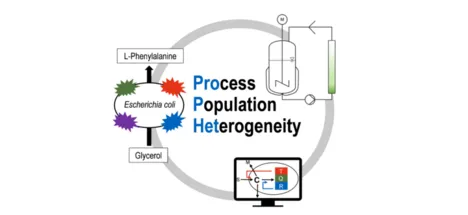ProPhet: Analysis of population heterogeneity induced variations in process performance
Population heterogeneity is a phenomenon that occurs in all bioprocesses independent of the studied organism. It is a common consequence during the upscaling of a bioprocess to an industrial-scale bioprocess, where concentration gradients of process parameters arise from mixing insufficiencies due to higher viscosities and higher volumes. Single cells in a bioreactor are therefore exposed to environmental changes. An originally isogenic monoculture can then evolve to an intra-species culture with different phenotypes to cope with this dynamic environment, leading to possibly reduced yield, productivity, growth and increased by-product formation. But on the other hand, population heterogeneity can also result in cells with improved fitness due to a higher stress tolerance from adapting to the fluctuating environment. Even though the phenomenon of population heterogeneity is well-known, the origins and mechanisms are poorly understood. Gaining a better understanding of the changes of the individual cells and their interaction with the environment, can therefore be beneficial to the optimization of bioprocesses.
To study this, this project focuses on the understanding of extrinsic population heterogeneity originating from cell-bioreactor interaction in fed-batch processes with Escherichia coli producing L-phenylalanine. Here, mathematical modelling of population dynamics can be employed to identify and explain the environmental and cellular factors that lead to noise and population heterogeneity. The project partner (Chair for Bioprocess Engineering, TUM) will develop a multiple reporter strain and investigate it in a scaled-down bioreactor on various cellular levels. The obtained experimental data is then integrated into the developed model. The model then can evaluate the interdependence between various traits, namely growth, general stress response, oxygen limitation and L-phenylalanine production, predict the behavior of the developed reporter strain in a scaled-up setting and serve as a foundation for further experiments. Additionally, the single cell physiology distributions of the multiple reporter strain will be evaluated for prominent strategies cells employ to cope with the environmental changes.
Former project supervision: Dr. Dieu Thi Doan
